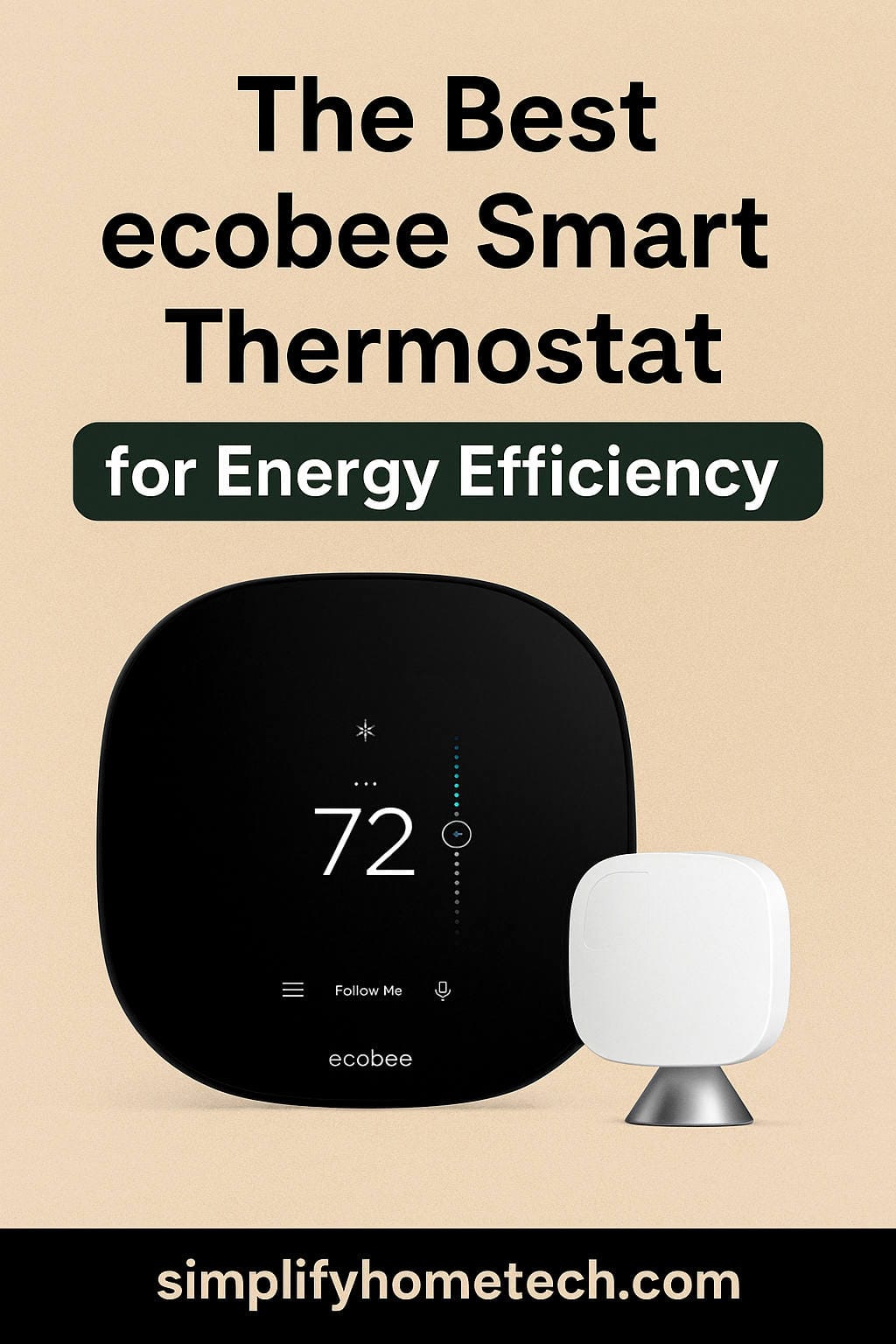As the world increasingly focuses on sustainable living, the spotlight turns to our homes, responsible for a significant portion of energy consumption globally. Smart thermostats have emerged as a beacon of innovation in this domain, leading the charge in energy efficiency. Ecobee, a pioneer in smart thermostat technology, has been instrumental in this shift towards smarter, more energy-conscious homes. By intelligently regulating home temperatures, Ecobee thermostats offer not just comfort and convenience but also substantial energy savings. In this in-depth blog post, we will explore how Ecobee’s range of smart thermostats stands out in their ability to blend advanced technology with user-friendly functionality, making them an essential component in modern, energy-efficient homes.
Overview of Ecobee Thermostats
Founded in 2007, Ecobee has established itself as a leader in smart home technology, primarily through its innovative range of smart thermostats. The company’s mission revolves around creating technology that improves both comfort and energy efficiency in homes and businesses. Over the years, Ecobee has received numerous accolades for its contributions to sustainable living, including awards for energy efficiency and design.
Ecobee’s product line has evolved significantly, with each new model introducing more advanced features. The brand’s commitment to user-friendly design, coupled with its focus on eco-conscious technology, has set it apart in a rapidly growing market. From the original Ecobee Smart Thermostat to the latest models with voice control and advanced sensor technology, each iteration has aimed at making homes smarter and more energy-efficient.
Key Features of Ecobee Thermostats for Energy Efficiency
Remote Sensors: A standout feature of Ecobee thermostats is their remote sensors. These devices can be placed in different rooms to measure temperature and occupancy. The thermostat uses this data to adjust heating or cooling in occupied spaces, avoiding wastage in unoccupied rooms. This targeted approach to temperature control is not only more efficient but also enhances comfort.
Geofencing and Learning Algorithms: Geofencing utilizes the homeowner’s smartphone location to adjust the home’s climate. When the phone is away from home, the thermostat sets itself to an energy-saving mode and resumes regular operation when the phone is detected nearby. Alongside, Ecobee’s learning algorithms analyze your schedule and temperature preferences over time to optimize energy use without compromising on comfort.
Smart Home Integration: Ecobee thermostats’ compatibility with various smart home systems like Apple HomeKit, Amazon Alexa, and Google Assistant allows for seamless integration. This feature enables users to control their home environment through voice commands or remotely via a smartphone, making energy management both convenient and efficient.
Energy Reports: Ecobee provides detailed energy reports to users, offering insights into their heating and cooling patterns. These reports help homeowners understand their energy usage and identify opportunities for further savings.
Detailed Review of Top Ecobee Models
1. Ecobee SmartThermostat with Voice Control
Features and Technology: The Ecobee SmartThermostat with Voice Control is the flagship model of the Ecobee line. It includes a responsive touch display, a powerful quad-core processor, dual-band Wi-Fi, and far-field voice technology. The inclusion of Alexa Voice Service allows for voice-controlled temperature adjustments, hands-free calling, and additional Alexa functionalities directly from the thermostat.
Energy Efficiency: This model is equipped with enhanced algorithms that adapt to your schedule and preferences, optimizing energy usage while maintaining comfort. It’s Energy Star certified, indicating it meets strict energy efficiency guidelines set by the EPA.
User Experience: Users have praised the SmartThermostat for its intuitive interface and seamless integration with various smart home systems. The voice control feature is particularly appreciated for its convenience. The inclusion of a smart sensor in the box helps manage hot or cold spots in the home, making for a more consistent temperature throughout.
Installation and Compatibility: The installation process is straightforward, and the thermostat is compatible with most HVAC systems. Ecobee provides an easy-to-use app and detailed instructions for DIY installation.
Pros and Cons:
- Pros: Advanced voice control, smart sensor included, user-friendly interface, and comprehensive smart home integration.
- Cons: Higher price point than some competitors, voice control can be less useful in quieter home environments.
2. Ecobee3 Lite
Features and Technology: The Ecobee3 Lite maintains many of the essential features of its higher-end counterparts but at a more affordable price. It offers a touchscreen interface, compatibility with external room sensors, and the same smart home integrations as the more expensive models.
Energy Efficiency: Like the SmartThermostat, it’s Energy Star certified. It can be paired with Ecobee’s room sensors to deliver the right temperature in the rooms that matter most, ensuring efficient use of energy.
User Experience: Users often choose the Ecobee3 Lite for its balance between functionality and price. The interface is user-friendly, and the app provides comprehensive control and monitoring options. It doesn’t include a built-in voice assistant or an included room sensor, which are available in the more expensive model.
Installation and Compatibility: The installation is similar to other Ecobee models and is well-guided by the Ecobee app. It’s compatible with most North American HVAC systems.
Pros and Cons:
- Pros: Affordable, intuitive interface, compatible with external sensors, and robust smart home integration.
- Cons: Lacks built-in voice control and does not include a room sensor in the box.
3. Ecobee4
Features and Technology: The Ecobee4 is another popular model in the Ecobee range. It comes with a built-in Alexa Voice Service, meaning it can perform many of the same functions as an Amazon Echo, including playing music, reading news, and controlling other smart devices.
Energy Efficiency: The Ecobee4 is also Energy Star certified and can be paired with room sensors to manage unoccupied rooms’ temperatures, saving energy without compromising comfort.
User Experience: The built-in Alexa feature is a major selling point for many users, providing convenience and a range of functionalities. Its interface is straightforward, and the remote sensors are highly effective in managing home comfort.
Installation and Compatibility: Installation is DIY-friendly, with detailed instructions provided. It’s compatible with a wide range of heating and cooling systems.
Pros and Cons:
- Pros: Built-in Alexa, compatible with remote sensors, user-friendly, and versatile smart home integration.
- Cons: Slightly bulkier design than newer models, and the built-in speaker quality is not as high as dedicated smart speakers.
User Experience and Installation
One of the most lauded aspects of Ecobee thermostats is their user-friendly interface. The touch screen display is intuitive, making it easy for users to navigate through settings and preferences. The installation process is generally straightforward, and Ecobee provides detailed instructions and online support. Many users find that they can install the thermostat themselves without professional help.
The brand’s customer service is often highlighted in user reviews, with many appreciating the responsive and helpful support team. Common troubleshooting tips include ensuring a stable Wi-Fi connection and updating firmware for optimal performance.
Cost vs. Savings Analysis
While the initial investment in an Ecobee thermostat may be higher than a standard thermostat, the long-term savings are substantial. Users typically see a reduction in their energy bills within the first few months of installation. The energy reports provided by Ecobee help users to make informed decisions about their energy usage, leading to further savings.
Additionally, many utility companies offer rebates for installing smart thermostats, making them even more affordable. When compared to traditional thermostats over a period of several years, Ecobee thermostats not only pay for themselves but continue to provide savings through reduced energy consumption.
Environmental Impact
The impact of Ecobee thermostats on the environment is significant. By optimizing energy use in homes, these devices help to reduce the carbon footprint of households. This is particularly important in the context of global efforts to combat climate change. By reducing reliance on energy-intensive heating and cooling systems, Ecobee thermostats contribute to a decrease in greenhouse gas emissions.
Integrating Ecobee with Renewable Energy Sources
Ecobee’s compatibility with renewable energy sources, such as solar panels, enhances its sustainability. Households using renewable energy can integrate their Ecobee thermostat to maximize the use of this energy, further reducing their reliance on non-renewable energy sources.
Future of Smart Home Energy Management
Looking ahead, the potential for smart home energy management is vast. With advancements in AI and machine learning, future versions of Ecobee thermostats and similar devices are expected to offer even more sophisticated energy-saving features, contributing to a more sustainable world.
Conclusion
Ecobee thermostats represent a significant step forward in home energy management. Their combination of advanced features, user-friendly design, and commitment to sustainability make them an excellent choice for anyone looking to reduce their energy bills and environmental impact.
Frequently Asked Questions (FAQs)
Q: Are Ecobee thermostats compatible with all HVAC systems?
A: Ecobee thermostats are designed to be compatible with most residential heating, ventilation, and air conditioning (HVAC) systems, including gas, oil, electric, dual fuel, and heat pump systems. However, it’s advisable to check the specific compatibility details for each model on Ecobee’s website or consult with a professional before purchase.
Q: How does the remote sensor technology in Ecobee thermostats contribute to energy efficiency?
A: The remote sensors in Ecobee thermostats detect occupancy and temperature in different rooms, allowing the thermostat to adjust heating or cooling based on where people are. This targeted temperature control means that energy isn’t wasted heating or cooling empty rooms, leading to more efficient energy use and cost savings.
Q: Can I integrate my Ecobee thermostat with smart home assistants like Amazon Alexa and Google Assistant?
A: Yes, Ecobee thermostats can be integrated with major smart home assistants, including Amazon Alexa and Google Assistant. This integration allows for voice control of your heating and cooling, as well as other smart home devices linked to these assistants.
Q: What kind of energy savings can I expect with an Ecobee thermostat?
A: According to Ecobee, users can save up to 23% annually on heating and cooling costs. The actual savings will depend on individual usage, the size of the home, and the climate in your area.
Q: Is it possible to control multiple Ecobee thermostats from one account or app?
A: Yes, you can control multiple Ecobee thermostats from a single account using the Ecobee app. This is particularly useful for managing the climate in different areas of a large home or in multiple properties.
Q: How do the learning algorithms in Ecobee thermostats work to improve energy efficiency?
A: Ecobee’s learning algorithms analyze your daily schedule and temperature preferences over time. The thermostat uses this data to optimize your heating and cooling patterns, automatically adjusting to save energy while ensuring your comfort.
Q: Can I access energy usage reports with an Ecobee thermostat? How are these helpful?
A: Yes, Ecobee provides detailed energy usage reports. These reports show your heating and cooling patterns and suggest ways to improve efficiency. They can be a valuable tool for understanding and reducing your energy consumption.
Q: What should I do if my Ecobee thermostat isn’t responding or appears offline?
A: If your Ecobee thermostat is unresponsive or offline, first check your Wi-Fi connection. If the connection is stable, try resetting the thermostat. If problems persist, contact Ecobee’s customer support for assistance.
Q: Are there any government rebates available for installing an Ecobee thermostat?
A: Many regions offer rebates and incentives for installing smart thermostats like Ecobee. These rebates can offset the initial cost of purchase. Check with local energy companies or government environmental programs for available rebates in your area.
Q: How does Ecobee’s geofencing feature work, and how does it help in saving energy?
A: Geofencing uses the location of your smartphone to determine if you’re home or away. When you leave a predetermined area, the thermostat switches to an energy-saving mode. Upon your return, it resumes your preferred settings. This ensures that energy isn’t wasted heating or cooling an empty home.
You might also like,

